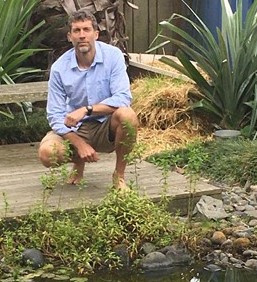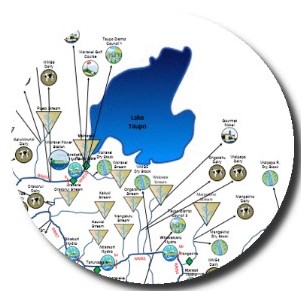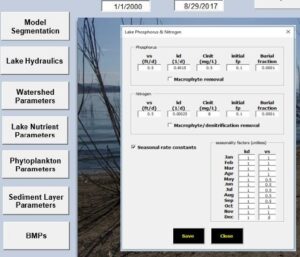 Mathematical modelling is Dr Tim Cox‘s “go to” for solving problems, understanding complex systems, interpreting datasets, and supporting decision-making.
Mathematical modelling is Dr Tim Cox‘s “go to” for solving problems, understanding complex systems, interpreting datasets, and supporting decision-making.
He has modelling expertise in water allocation, lake water quality and catchment water quality and contaminant allocation.
Simplified Water Allocation Model (SWAM)
 A TOOL FOR ROBUST WATER ALLOCATION PLANNING
A TOOL FOR ROBUST WATER ALLOCATION PLANNING
Meeting the requirements of the NPSFM around water accounting and allocation can be daunting, given the large number of water takes, environmental flow restrictions, prior use rights, seasonally varying demand and, of course, highly dynamic catchment hydrology.
Managing water takes by using “static” calculators based on the sum of allocated water as shown on resource consents is clearly not enough; to meet all the NPSFM requirements, regional councils require simple but robust and transparent tools for managing and allocating water. This is where SWAM – the Simplified Water Allocation Model – steps in…
SWAM was developed by Dr Tim Cox for the US consulting firm CDM Smith. It is a networked generalized water allocation modeling tool that can be easily and simply applied by a wide range of endusers in planning studies and consent decision-making. The model calculates physically and legally available water, diversions, storage, consumption and return flows at user-defined nodes in a networked river system.
SWAM fulfils the water quantity accounting requirements of the NPSFM. It also allows water allocations and trade-offs between users to be explored, and provides for long-term planning of basin water supply alternatives, ecological flow targets, and water permit allocation.
A PROVEN EFFECTIVE PLANNING TOOL
SWAM has been used for multiple applications in the USA (including for the whole state of South Carolina). It has also been used for pioneering water allocation planning in Tanzania. In New Zealand, Tim has used SWAM in both the Upper and Lower Waikato catchments.
TECHNICAL DETAILS
SWAM is a Visual Basic program hosted in an Excel computing environment. The user interface consists of a single worksheet with drop-and-drag graphical features for defining and parameterising a water supply network. The model is object oriented, which allows features such as tributaries, reservoirs, water supply users, agricultural users and aquifers to be easily constructed and identified on the network. SWAM is ideally suited for stakeholder engagement; the graphical interface allows stakeholders to “see” where they are within a catchment and how changing the water take regime on their property will affect other users.
CLIENTS GET A FULLY OPERATIONAL MODEL
Tim can implement, run and report on the model. He can also provide the implemented model as fully functioning software together with a user’s manual. Training can also be provided. This way, clients can run their own scenarios without needing to pay additional consulting fees.
Click here to return to top.
Simplified Lake Analysis Model (SLAM)
 A PRACTICAL AND ROBUST TOOL FOR MODELLING LAKE WATER QUALITY
A PRACTICAL AND ROBUST TOOL FOR MODELLING LAKE WATER QUALITY
The Simplified Lake Analysis Model simulates lake nutrient and phytoplankton dynamics. It was developed by Dr Tim Cox for the US consulting firm CDM Smith to satisfy a need for a practical model that can be easily and simply applied in planning studies by a wide range of endusers.
TRACK RECORD
Tim has used SLAM in planning, permitting and restoration studies across the US, in New Zealand and in the UK.
In New Zealand, Tim used the model to evaluate the effectiveness of a proposed river-water flushing scheme designed to improve water quality in heavily-polluted Lake Waikare (36 square km in area). The model simulated a scheme to divert large volumes of local river water into the lake to flush lake nutrients and phytoplankton. The calibrated model helped to better define and understand existing lake water quality dynamics, and revealed the large impact of catchment agriculture on lake water quality. Modelling results showed a potential for significant improvements in water quality from the proposed diversion, but at the expense of impaired quality in downstream receiving waters. In another New Zealand study, Tim used SLAM to assess the impacts of new development on an urban lake in Hamilton (Rotokauri) and to forecast water quality for a new constructed lake in northern Waikato.
Overseas, Tim used SLAM in a $100 million restoration project for Machado Lake (Los Angeles, CA). The model was used to develop and evaluate a suite of restoration strategies that have subsequently been implemented to reduce lake nutrient and phytoplankton levels. SLAM is currently being used by the Ireland Environmental Protection Agency to help guide lake and catchment restoration projects and target-setting. In support of permitting, Tim used SLAM to quantify the impacts of a proposed new discharger on lake phytoplankton levels in Lake Wichita (Wichita Falls, TX) and to perform total maximum daily load (TMDL) analyses for multiple lakes in Illinois, for the state Environmental Protection Agency.
MODEL BASIS
SLAM targets the key parameters for eutrophic lakes: phytoplankton (as chl-a), phosphorus (P) and nitrogen (N).
The model calculates lake mass and flow balances on a daily time-step assuming one or more well-mixed lake zones. Each zone is depicted in the model as a “continuously stirred tank reactor” in which complete and immediate mixing is assumed in both the vertical and horizontal directions. This assumption makes the model particularly well suited for lakes that are generally well mixed and that can be divided into a limited number of small and/or shallow zones. For deeper lakes, SLAM does not explicitly calculate lake stratification, but does allow for user-defined seasonal stratification.
An established, peer-reviewed empirical model is used to describe the relationship between summer phytoplankton levels and lake nutrient concentrations and hydraulics. Lake watershed hydrology and pollutant loadings can either be explicitly calculated by the model or can be user prescribed.
IN-LAKE BMPS
SLAM allows for quick and easy simulations of a variety of in-lake best management practices (BMPs), including sediment dredging, hypolimnetic oxygenation, supplemental water inputs, pump and treat systems, alum application, and re-circulating off-channel wetlands treatment.
SEDIMENT NUTRIENT FLUXES
SLAM includes a state-of-the-art dynamic sediment nutrient flux module, which calculates internal nutrient loads from the sediments to the water column as a function of shallow sediment nutrient dynamics and diffusive exchanges between sediment porewater and the overlying water column. Internal nutrient loads are a key component of many eutrophic lakes. The inclusion of dynamic and rigorous sediment nutrient calculations within a practical planning-level water quality model distinguishes SLAM from most other published lake water quality models.
Click here to return to top.
Catchment water quality modeling and contaminant allocation
Dr. Cox has developed his own models to simulate both diffuse- and point-source pollution at a catchment scale. He uses his own standardised and generalised approach to create models that are transparent, usable and defensible, and that make full use of the best available science. His approach has proven to be highly effective for regional planning studies.
CONTAMINANT ALLOCATION AND THE NPSFM
The NPS for Freshwater Management sets out the policy framework for the management of NZ’s freshwater into the future. Regional councils are required to manage contaminants by establishing a freshwater quality accounting system when setting or reviewing objectives and limits and setting enforceable load limits for contaminants entering water bodies. Limits need to be set using the best available scientific and socio-economic information. To meet these requirements, regional councils and other stakeholders need effective modelling tools. Existing tools are generally either highly simplistic, customized spreadsheet applications that lack in predictive power or transferability; or they are overly complex mechanistic catchment water quality models, lacking in spatial resolution and usability. Tim’s modeling tools endeavour to overcome these limitations.
A PROVEN EFFECTIVE APPROACH
Tim provided modeling in support of Waikato Regional Council’s Healthy Rivers Plan Change 1 (PC1) process. He developed a catchment water quality model, using his own generalized software, that spanned the entirety of the Waikato River catchment. The model was used to simulate the generation, fate, and transport of nitrogen and phosphorus through a dendritic network of the catchment’s major tributaries. More recently, Dr. Cox has developed models for both Horizons Regional Council (HRC) and Environment Southland (ES). The HRC models were successfully used to support the proposed Plan Change 2 to the Manawatu-Whanganui One Plan. The ES models will be used by Council staff for ongoing planning decision support, including nutrient limit setting as required by the NPSFM. Model and software training are to be provided to ES staff to enable in-house use of the models going forward.
APPROACH FEATURES
• Ability to simulate a wide range of contaminants.
• Allow for easy investigation of mitigations.
• Highly usable with a graphical interface that is easy to navigate.
• Provide for 3 different modes of simulation: deterministic, stochastic, and optimisation.
• Ability to implement at multiple scales from large catchments to individual properties.
• Spatially and temporally variable at differing levels of resolution (e.g. lumped vs. node-based; annual average vs. seasonal), as required.
• Portability and platform familiarity.
• Allow for stakeholder engagement, using a graphical interface allows stakeholders to “see” where they are within a catchment and how reducing contaminant loads from their property will contribute to meeting catchment objectives.
• Provide for the contaminant accounting requirements of the NPSFM.
• Allow for the exploration of contaminant allocations and trade-offs.
MITIGATION AND OPTIMISATION
An objective of any limit-setting process usually involves reducing contaminant loads to meet water quality objectives at various locations in the catchment. Tim’s modelling approach translates estimates of on-farm, edge-of-field and instream load reductions associated with specific mitigation options into cumulative impacts, in the form of both total load and average contaminant concentrations, at key downstream locations. Model simulations can be performed to investigate the extent to which any given mitigation strategy will achieve water quality targets throughout the catchment. Simple optimization algorithms can then be employed to identify the best way (types and placements of mitigations) to achieve receiving-environment objectives while minimising mitigation costs.
STOCHASTIC MODE OF SIMULATION
Stochastic model simulations can provide valuable information regarding the levels of uncertainty associated with load and concentration projections, as well as the range of variability around modelled water quality objectives. Rather than single value outputs, stochastic simulations present output in terms of exceedance probabilities (or “risk”). Simple probability distributions can be defined for both load and attenuation input parameters. Internally, model algorithms randomly sample the prescribed input distributions for a user-defined number of iterations, storing calculated outputs for each iteration and fitting percentile distributions to the final output sets. This form of output can be extremely useful for decision-making
FLEXIBLE CALIBRATION METHODS
Tim’s approach allows for multiple approaches to model parameter calibration that can be tailored to a given system and dataset. His models have included “auto-calibration” options, which use an optimisation routine to quantify parameter sets that minimise differences between modeled and measured data. In other applications, Tim has effectively incorporated outside knowledge and expertise, including known physiographic characteristics, to establish a sensible and defensible calibrated parameter set.
CLIENTS GET A FULLY OPERATIONAL MODEL
Tim can implement, run and report on the models that he develops. He can also provide the implemented model as fully functioning software together with a user’s guide. Training can also be provided. This way, clients can run their own scenarios without needing to pay additional consulting fees.
Click here to return to top.

